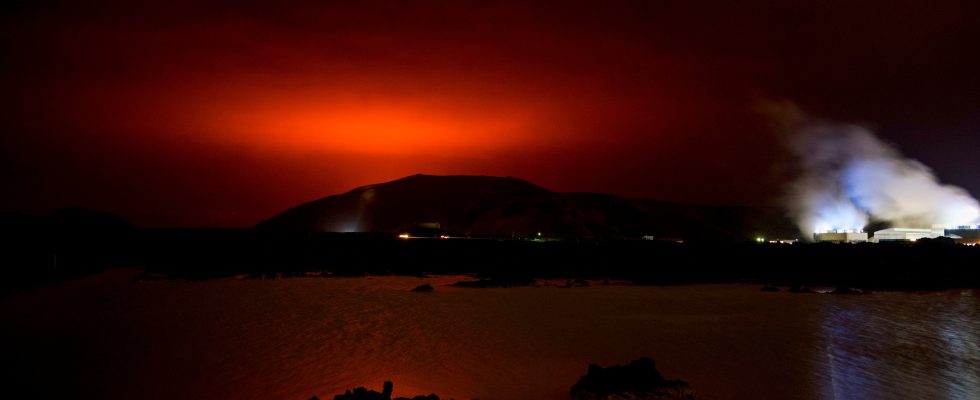It’s a matter of hours or days: Iceland is preparing for a probable volcanic eruption. On Friday, November 10, the country’s authorities declared a state of emergency and ordered the evacuation of the town of Grindavik, on the Reykjanes Peninsula, southwest of the capital Reykjavik. The decision was made after a series of powerful earthquakes and a rapid rise of magma to the surface near the Sundhnjukagigar site. Experts are now warning of a possible volcanic eruption in the coming hours at the earliest. This natural phenomenon, they warn, could be much more powerful than the last three.
Concerns about a new volcanic eruption emerged last Thursday, as southwest Iceland has faced significant seismic activity since late October. A recurring phenomenon on this island with 33 active volcanoes, which on October 27 caused an accumulation of magma at a depth of 5 kilometers and a swelling of the ground, near the Sundhnjukagigar site. But there is nothing to predict an eruption, says the Icelandic Meteorological Institute (IMO).
Magma near the surface
However, the phenomenon accelerated this week. While the IMO has recorded more than 23,000 earthquakes since October 25, more than 400 tremors were recorded between Wednesday November 8 and Thursday November 9. Result: the “blue lagoon”, a famous spa resort and tourist site in southwest Iceland, temporarily closes as a precaution. The next day, two major earthquakes shook the Icelandic land, the strongest of which was measured at a magnitude of 5.2. More than 800 tremors were finally recorded on the morning of Friday, November 10 alone.
A few hours later, the Icelandic Meteorological Institute noted that the accumulation of magma from recent days had begun to rise vertically towards the earth’s crust. The magma is only “800 meters below the surface”, estimates the IMO’s volcanic risks coordinator, Sara Barsotti. The conditional is no longer relevant: on Friday, the Icelandic authorities declared a state of emergency, while experts announced on Saturday an eruption in the coming hours or days.
Risk of destruction of the city of Grindavik
Although Iceland has experienced several recent volcanic phenomena, this predicted eruption this time threatens inhabited areas. Three kilometers from the epicenter of the tremors and the accumulation of magma, the ground in the town of Grindavik has been tearing apart since Friday. Long cracks appeared on roads, buildings and across the local golf course.
During the night from Friday to Saturday, the authorities ordered the evacuation of the 4,000 residents of this small port town southwest of Reykjavik. Emergency shelters and aid centers are also open in several neighboring towns. For IMO experts, it is likely that “the magma intrusion extended beneath Grindavik”.
A large crack 15 kilometers long near the city is of particular concern to experts. “Anywhere on this fissure we can see that an eruption could occur,” Vidir Reynisson, head of civil protection and emergency management in Iceland, told AFP on Saturday. Beyond the risk of destroying houses in Gindavik, this eruption could also threaten the region’s infrastructure. The town is notably close to the Svartsengi geothermal power plant, which provides most of the electricity and water for the 30,000 inhabitants of the Reykjanes peninsula.
Furthermore, Vidir Reynisson has reported to the British daily The Guardian that an eruption at the bottom of the ocean remains possible “because the end of the fissure flows into the sea”. Although less threatening to Icelanders, this scenario would likely cause a large ash cloud, similar to the eruption of Eyjafjallajökull in 2010. The cloud then blocked European skies, canceling more than 100,000 flights and stranding ten million passengers.
Towards an eruption more powerful than the previous ones?
Whatever the type of eruption, this volcanic phenomenon already considered “an unprecedented event” by experts. However, the island is accustomed to significant volcanic phenomena. Since 2021, three eruptions have taken place on the Reykjanes Peninsula: in March 2021, August 2022 and July 2023. All linked to the Fagradalsfjall volcano, far from infrastructure and populated areas.
But this time, the weather service noted that “the amount of magma involved is significantly greater than what had been observed during the largest magma intrusions associated with the Fagradalsfjall eruptions.” Thus, the consequences for the city Grindavik could “be much worse” than the eruption of Vestmannaeyjar which destroyed the port town 50 years ago, estimates volcanologist Ármann Höskuldsson on Icelandic public television RÚV.
According to IMO coordinator Sara Barsotti, the Earth’s crust has been so fractured over the past three years by these eruptions that magmatic fluids were able to find their way out more quickly this time. A trend that could continue in the future: volcanologists estimate that this new cycle of increased activity could last several decades, even several centuries.
